Returning Cropland to Grassland as a Potential Method for Increasing Carbon Storage in Dry-Hot Valley Areas
Abstract
1. Introduction
2. Materials and Methods
2.1. Study Area
2.2. Data Sources and Preprocessing
2.3. Research Framework
2.4. Methods
2.4.1. Land Use Transition Matrix
2.4.2. Spatial Heterogeneity Analysis Based on the Geo-Detector Model
2.4.3. Using the InVEST Model to Estimate Carbon Storage
3. Results
3.1. Land Use Changes in Yanjin County from 2000 to 2019
3.2. Spatial and Temporal Distribution of Carbon Storage in Yanjin County from 2000 to 2019
3.2.1. Carbon Storage Characteristics Related to Temporal Variations
3.2.2. Spatial Distribution Characteristics of Carbon Storage
3.2.3. Analyzing the Factors Influencing the Spatial Differentiation of Carbon Storage
3.3. Impacts of the GFGP on Carbon Storage in Terrestrial Ecosystems
3.4. Comparison of the Carbon Sequestration Capacity of Different Methods of Returning Cropland
3.4.1. Spatial Distribution of the Implementation Area of the GFGP
3.4.2. Carbon Sequestration Effect of Different Methods of Cropland Return
4. Discussion
4.1. Returning Cropland to Grassland Exhibits Great Potential for Carbon Sequestration
4.2. Total Carbon Storage Exhibits Two Decrease and Increase Stages during GFGP Implementation
4.3. Elevation Is the Dominant Factor in the Spatial Differentiation of Carbon Storage
4.4. Uncertainties and Prospect
5. Conclusions
Author Contributions
Funding
Institutional Review Board Statement
Informed Consent Statement
Data Availability Statement
Acknowledgments
Conflicts of Interest
References
- Canadell, J.G.; Raupach, M.R. Managing Forests for Climate Change Mitigation. Science 2008, 320, 1456–1457. [Google Scholar] [CrossRef] [PubMed]
- Letourneau, A.; Verburg, P.H.; Stehfest, E. A land-use systems approach to represent land-use dynamics at continental and global scales. Environ. Model. 2012, 33, 61–79. [Google Scholar] [CrossRef]
- Ewane, E.B.; Deh-Nji, A.; Mfonkwet, N.Y.; Nkembi, L. Agricultural expansion and land use land cover changes in the Mount Bamboutos landscape, Western Cameroon: Implications for local land use planning and sustainable development. Int. J. Environ. Stud. 2023, 80, 186–206. [Google Scholar] [CrossRef]
- Toro, G.; Otero, M.P.; Clerici, N.; Szantoi, Z.; González-González, A.; Escobedo, F.J. Interacting municipal-level anthropogenic and ecological disturbances drive changes in Neotropical forest carbon storage. Front. Environ. Sci. 2022, 10, 937147. [Google Scholar] [CrossRef]
- Li, J.-P.; Xia, S.-X.; Yu, X.-B.; Li, S.-X.; Xu, C.; Zhao, N.; Wang, S.-T. Evaluation of carbon storage on terrestrial ecosystem in Hebei province based on InVEST model. J. Ecol. Rural Environ. 2020, 36, 854–861. [Google Scholar]
- Li, K.-R. Research Progress of Global Climate Change and Its Impact and Future Prospect. Acta Geogr. Sin. 1996, S1, 1–14. [Google Scholar]
- Sleeter, B.M.; Marvin, D.C.; Cameron, D.R.; Selmants, P.C.; Westerling, A.L.; Kreitler, J.; Daniel, C.J.; Liu, J.; Wilson, T.S. Effects of 21st-century climate, land use, and disturbances on ecosystem carbon balance in California. Glob. Change Biol. 2019, 25, 3334–3353. [Google Scholar] [CrossRef] [PubMed]
- Cantarello, E.; Newton, A.C.; Hill, R.A. Potential effects of future land-use change on regional carbon stocks in the UK. Environ. Sci. Policy 2011, 14, 40–52. [Google Scholar] [CrossRef]
- Chen, G.-S.; Tian, H.-Q. The impact of land use/cover change on the carbon cycle of terrestrial ecosystems. Chin. J. Plant Ecol. 2007, 31, 189–204. [Google Scholar]
- Chuai, X.; Huang, X.; Wang, W.; Zhao, R.; Zhang, M.; Wu, C. Land use, total carbon emissions change and low carbon land management in Coastal Jiangsu, China. J. Clean. Prod. 2015, 103, 77–86. [Google Scholar] [CrossRef]
- Yang, Y.; Shi, Y.; Sun, W.; Chang, J.; Zhu, J.; Chen, L.; Wang, X.; Guo, Y.; Zhang, H.; Yu, L.; et al. Terrestrial carbon sinks in China and around the world and their contribution to carbon neutrality. Sci. China Life Sci. 2022, 65, 861–895. [Google Scholar] [CrossRef] [PubMed]
- Posner, S.; Verutes, G.; Koh, I.; Denu, D.; Ricketts, T. Global use of ecosystem service models. Ecosyst. Serv. 2016, 17, 131–141. [Google Scholar] [CrossRef]
- Heimann, M.; Reichstein, M. Terrestrial ecosystem carbon dynamics and climate feedbacks. Nature 2008, 451, 289–292. [Google Scholar] [CrossRef] [PubMed]
- Tang, X.; Liu, S.; Zhou, G. Erosion and vegetation restoration impacts on ecosystem carbon dynamics in South China. Soil Sci. Soc. Am. J. 2010, 74, 272–281. [Google Scholar] [CrossRef]
- Deng, L.; Liu, S.; Kim, D.G.; Peng, C.; Sweeney, S.; Shangguan, Z. Past and future carbon sequestration benefits of China’s grain for green program. Glob. Environ. Change 2017, 47, 13–20. [Google Scholar] [CrossRef]
- Martin, P.; Jesper, M.; Madelene, O.; Jin-tao, X. The Chinese Grain for Green Programme: Assessing the carbon sequestered via land reform. J. Environ. Manag. 2013, 126, 142–146. [Google Scholar]
- Persson, M.; Moberg, J.; Ostwald, M.; Xu, J. Soil carbon sequestration potential for “Grain for Green” project in Loess Plateau, China. Environ. Manag. 2011, 48, 1158–1172. [Google Scholar]
- Wang, K.; Hu, D.; Deng, J.; Shangguan, Z.; Deng, L. Biomass carbon storages and carbon sequestration potentials of the Grain for Green Program-Covered Forests in China. Ecol. Evol. 2018, 8, 7451–7461. [Google Scholar] [CrossRef] [PubMed]
- Yao, N.; Liu, G.-Q.; Yao, S.-B.; Deng, Y.-J.; Hou, M.-Y.; Zhang, X. Evaluating on Effect of Conversion from Farmland to Forest and Grassland Porject on Ecosystem Carbon Storage in Loess Hilly-gully Region Based on InVEST Model. Bull. Soiland Water Conserv. 2022, 42, 329–336. [Google Scholar]
- Hu, X.; Li, Z.; Chen, J.; Nie, X.; Liu, J.; Wang, L.; Ning, K. Carbon sequestration benefits of the grain for Green Program in the hilly red soil region of southern China. Int. Soil Water Conserv. Res. 2021, 9, 271–278. [Google Scholar] [CrossRef]
- Wang, X.; Zhang, X.; Feng, X.; Liu, S.; Yin, L.; Chen, Y. Trade-offs and synergies of ecosystem services in karst area of China driven by grain-for-green Program. Chin. Geogr. Sci. 2020, 30, 101–114. [Google Scholar] [CrossRef]
- Jia, X.; Fu, B.; Feng, X.; Hou, G.; Liu, Y.; Wang, X. The tradeoff and synergy between ecosystem services in the Grain-for-Green areas in Northern Shaanxi, China. Ecol. Indic. 2014, 43, 103–113. [Google Scholar] [CrossRef]
- Deng, L.; Shangguan, Z.; Sweeney, S. “Grain for Green” driven land use change and carbon sequestration on the Loess Plateau, China. Sci. Rep. 2014, 4, 7039. [Google Scholar] [CrossRef] [PubMed]
- Yang, J.; Huang, X. The 30 m annual land cover dataset and its dynamics in China from 1990 to 2019. Earth Syst. Sci. Data 2021, 13, 3907–3925. [Google Scholar] [CrossRef]
- GB/T21010-2017; Current Land Use Classification. Available online: https://openstd.samr.gov.cn/ (accessed on 4 April 2024).
- Liu, X.-J.; Li, X.; Liang, X.; Shi, H.; Ou, J.-P. Simulating the change of terrestrial carbon storage in China based on the FLUS-InVEST model. Trop. Geogr. 2019, 39, 397–409. [Google Scholar]
- Mokany, K.; Raison, R.J.; Prokushkin, A.S. Critical analysis of root: Shoot ratios in terrestrial biomes. Glob. Change Biol. 2006, 12, 84–96. [Google Scholar] [CrossRef]
- Delaney, M.; Brown, S.; Lugo, A.E.; Torres-Lezama, A.; Quintero, N.B. The quantity and turnover of dead wood in permanent forest plots in six life zones of Venezuela 1. Biotropica 1998, 30, 2–11. [Google Scholar] [CrossRef]
- Balasubramanian, D.; Zhou, W.J.; Ji, H.L.; Grace, J.; Bai, X.-L.; Song, Q.-H.; Liu, Y.-T.; Sha, L.-Q.; Fei, X.-H.; Zhang, X.; et al. Environmental and management controls of soil carbon storage in grasslands of southwestern China. J. Environ. Manag. 2020, 254, 109810. [Google Scholar] [CrossRef]
- Mazarrasa, I.; Samper-Villarreal, J.; Serrano, O.; Lavery, P.S.; Lovelock, C.E.; Marbà, N.; Duarte, C.M.; Cortés, J. Habitat characteristics provide insights of carbon storage in seagrass meadows. Mar. Pollut. Bull. 2018, 134, 106–117. [Google Scholar] [CrossRef]
- González-Díaz, P.; Ruiz-Benito, P.; Ruiz, J.G.; Chamorro, G.; Zavala, M.A. A Multifactorial Approach to Value Supporting Ecosystem Services in Spanish Forests and Its Implications in a Warming World. Sustainability 2019, 11, 358. [Google Scholar] [CrossRef]
- Li, H. The Evaluation on Ecological Effects of the Project of Returning Farmland to Forest in Liaoning Province, Based on Remote Sensing and in VEST Model. Ph.D. Thesis, Jilin University, Changchun, China, 2019. [Google Scholar]
- Wang, J.-F.; Xu, C.-D. Geodetector: Principle and prospective. Acta Geogr. Sin. 2017, 72, 116–134. [Google Scholar]
- Zhang, Y.; Xie, Y.-C.; Qi, S.-H.; Gong, J.; Zhang, L. Carbon storage and spatial distribution characteristics in the Bailongjiang Watershed in Gansu based on InVEST model. Resour. Sci. 2016, 38, 1585–1593. [Google Scholar] [CrossRef]
- Feng, Y.; Chen, S.; Tong, X.; Lei, Z.; Gao, C.; Wang, J. Modeling changes in China’s 2000–2030 carbon stock caused by land use change. J. Clean. Prod. 2020, 252, 119659. [Google Scholar] [CrossRef]
- Zhao, Q.-G.; Huang, G.-Q.; Ma, Y.-Q. The problems in red soil ecosystem in southern of China and its countermeasures. Acta Ecol. Sin. 2013, 33, 7615–7622. [Google Scholar]
- Zhu, E.; Deng, J.; Zhou, M.; Gan, M.; Jiang, R.; Wang, K.; Shahtahmassebi, A. Carbon emissions induced by land-use and land-cover change from 1970 to 2010 in Zhejiang, China. Sci. Total Environ. 2019, 646, 930–939. [Google Scholar] [CrossRef] [PubMed]
- Hu, S.; Zhang, X.-R.; Guan, D.-J. Analysis on carbon storage change of construction land expansion in chongqing based on InVEST model. Res. Soil Water Conserv. 2018, 25, 323–331. [Google Scholar]
- Xiang, S.; Zhang, Q.; Wang, D.; Wang, S.; Wang, Z.-F.; Xie, Y.-Q.; Gao, M. Response and vulnerability analysis of carbon storage to LUCC in the main urban area of Chongqing during 2000–2020. J. Nat. Resour. 2022, 37, 1198–1213. [Google Scholar] [CrossRef]
- Li, M.-Y.; Shangguan, Z.-P.; Deng, L. Spatial distribution of carbon storages in the terrestrial ecosystems and its influencing factors on the Loess Plateau. Acta Ecol. Sin. 2021, 41, 6786–6799. [Google Scholar]
- Li, R.; Ye, C.; Wang, Y.; Han, G.; Sun, J. Carbon storage estimation and its drivering force analysis based on InVEST model in the Tibetan Plateau. Acta Agrestia Sin. 2021, 29, 43. [Google Scholar]
- Wang, C.; Luo, J.; Qing, F.; Tang, Y.; Wang, Y. Analysis of the Driving Force of Spatial and Temporal Differentiation of Carbon Storage in Taihang Mountains Based on InVEST Model. Appl. Sci. 2022, 12, 10662. [Google Scholar] [CrossRef]
- Hao, R.-W.; Zhou, R.-P.; Hu, S.-L.; Huge, J.-L. Simulating Carbon Sinks and Determining Driving Factors of Inner Mongolia Section in Yellow River Basin. Bull. Soiland Water Conserv. 2024, 44, 465–476. [Google Scholar]
- Du, J.; Shu, J.; Yin, J.; Yuan, X.; Jiaerheng, A.; Xiong, S.; He, P.; Liu, W. Analysis on spatio-temporal trends and drivers in vegetation growth during recent decades in Xinjiang, China. Int. J. Appl. Earth Obs. Geoinf. 2015, 38, 216–228. [Google Scholar] [CrossRef]
- Zhang, X.; Yue, Y.; Tong, X.; Wang, K.; Qi, X.; Deng, C.; Brandt, M. Eco-engineering controls vegetation trends in southwest China karst. Sci. Total Environ. 2021, 770, 145160. [Google Scholar] [CrossRef] [PubMed]
- Huo, H.; Sun, C. Spatiotemporal variation and influencing factors of vegetation dynamics based on Geodetector: A case study of the northwestern Yunnan Plateau, China. Ecol. Indic. 2021, 130, 108005. [Google Scholar] [CrossRef]
- Xu, J.; Chen, J.; Liu, Y. Partitioned responses of ecosystem services and their tradeoffs to human activities in the Belt and Road region. J. Clean. Prod. 2020, 276, 123205. [Google Scholar]
- Piao, S.; He, Y.; Wang, X.; Chen, F. Estimation of China’s terrestrial ecosystem carbon sink: Methods, progress and prospects. Sci. China Earth Sci. 2022, 65, 641–651. [Google Scholar] [CrossRef]
- Dong, J.W.; Kuang, W.H.; Liu, J.Y. Continuous land cover change monitoring in the remote sensing big data era. Sci. China Earth Sci. 2017, 60, 2223–2224. [Google Scholar] [CrossRef]
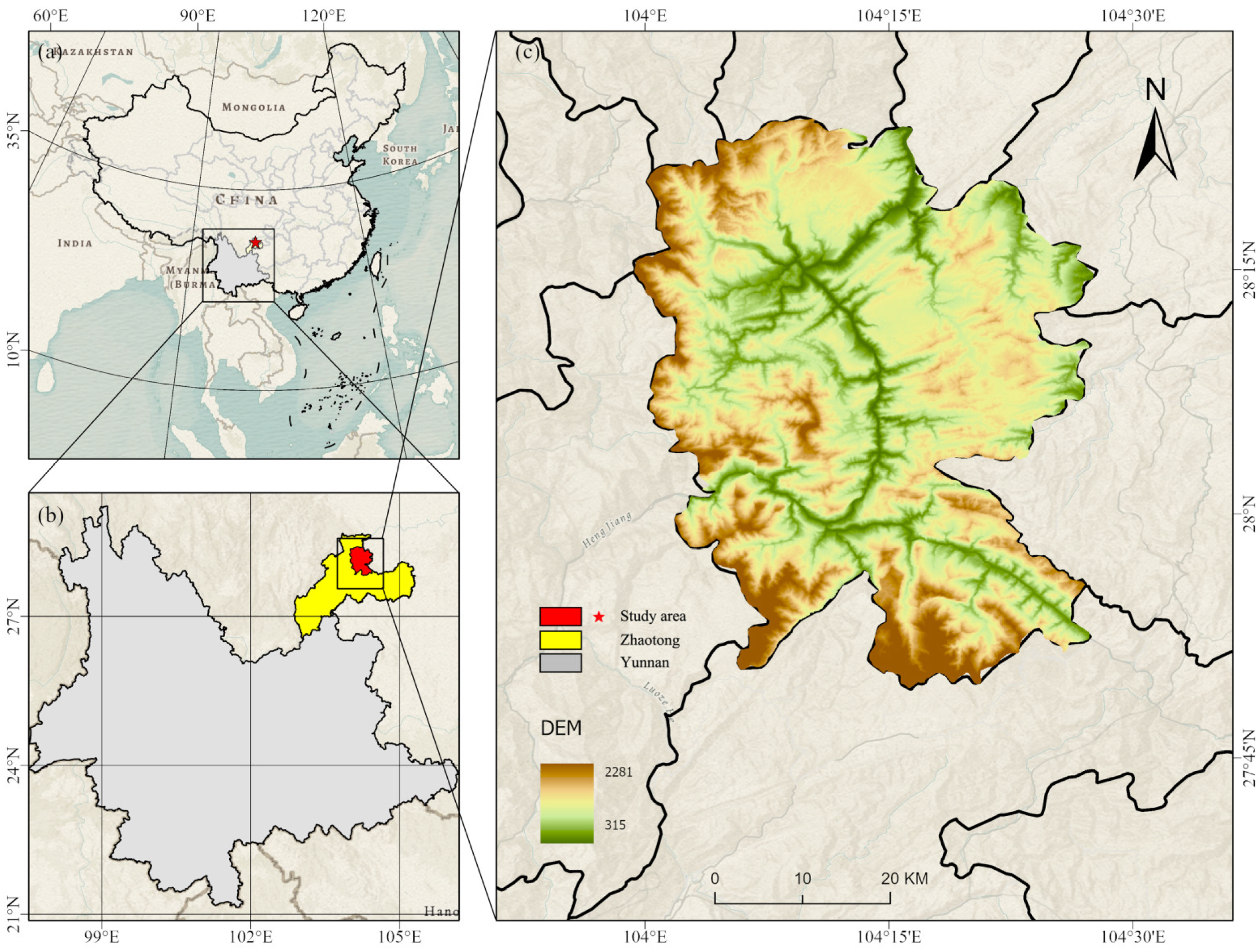
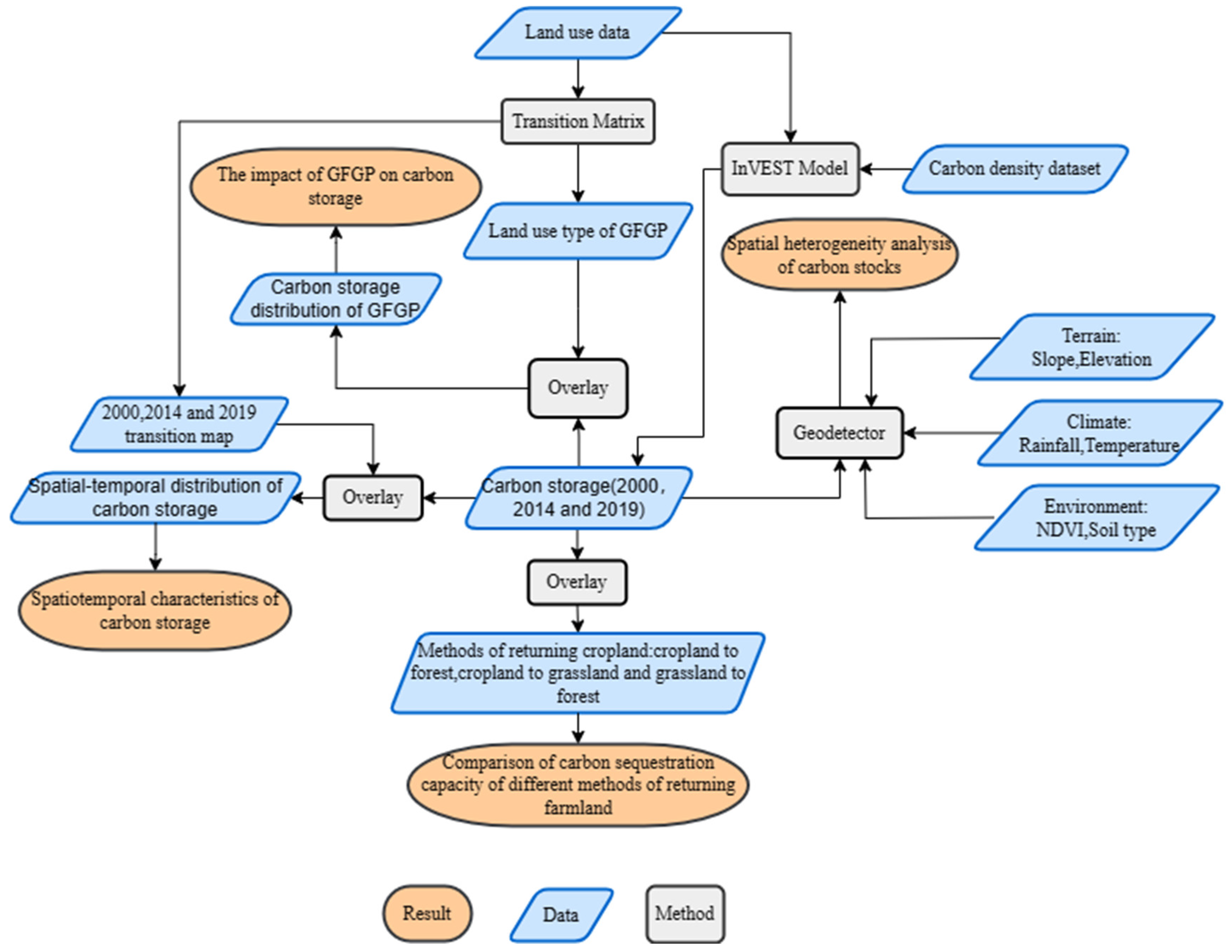


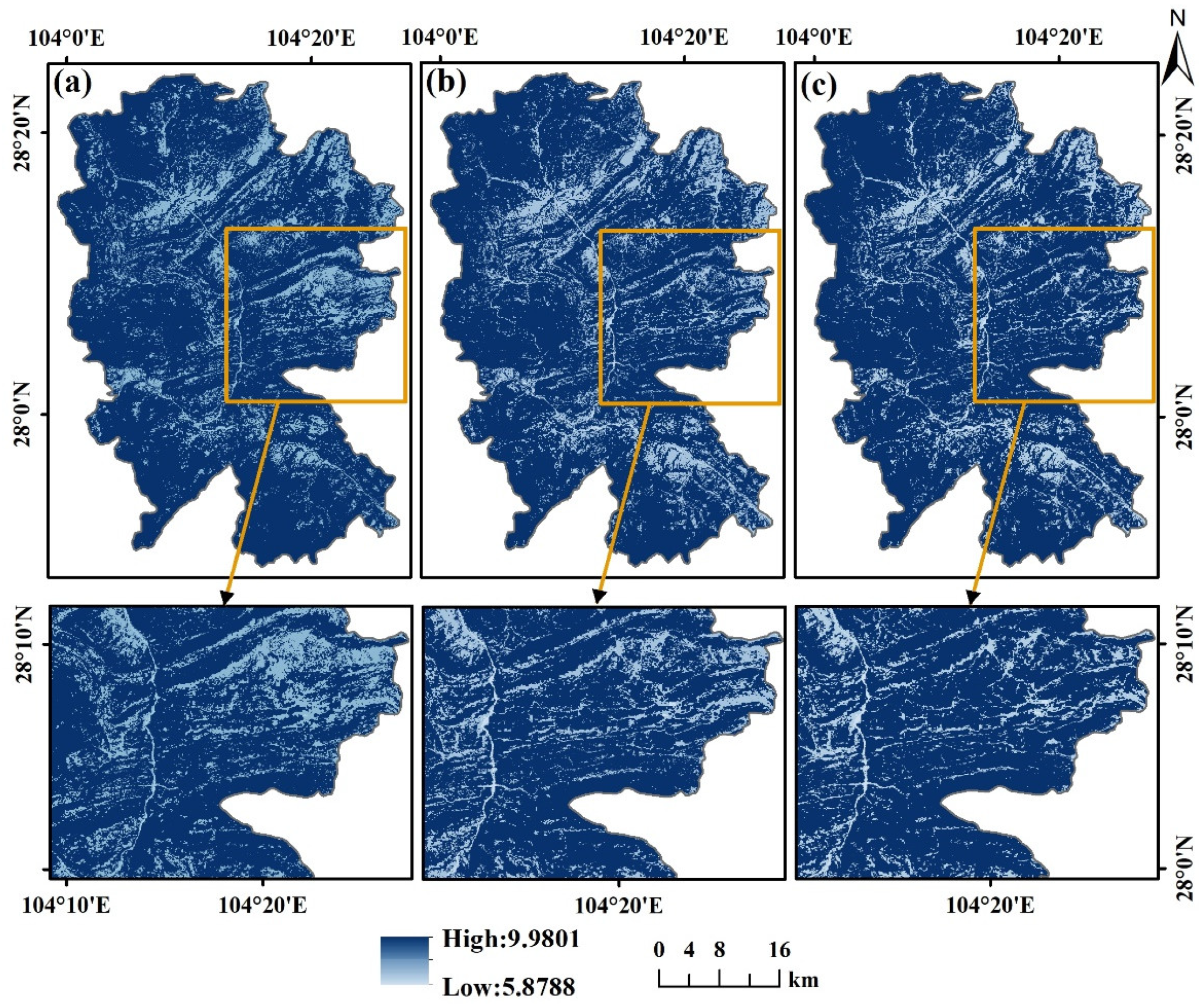
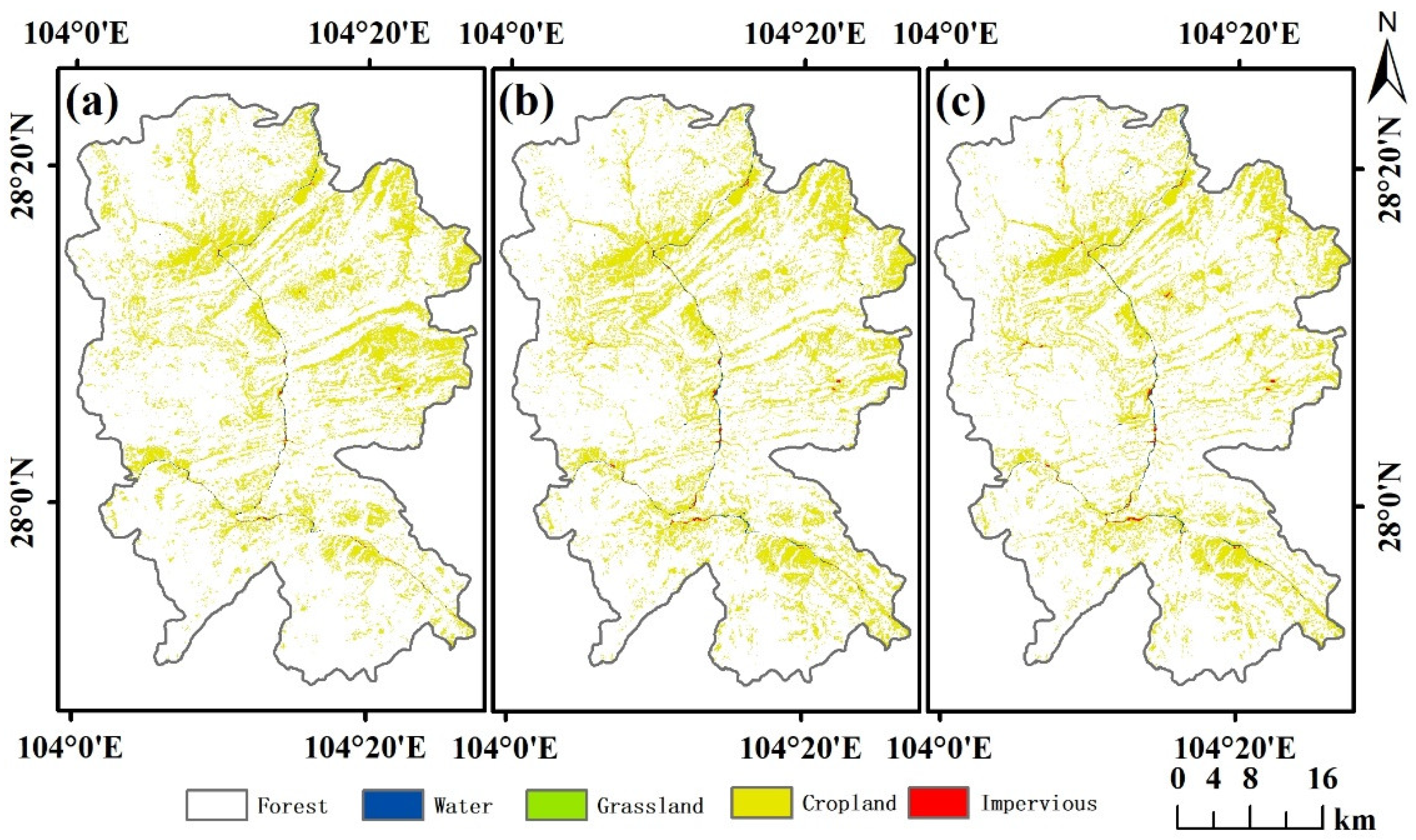



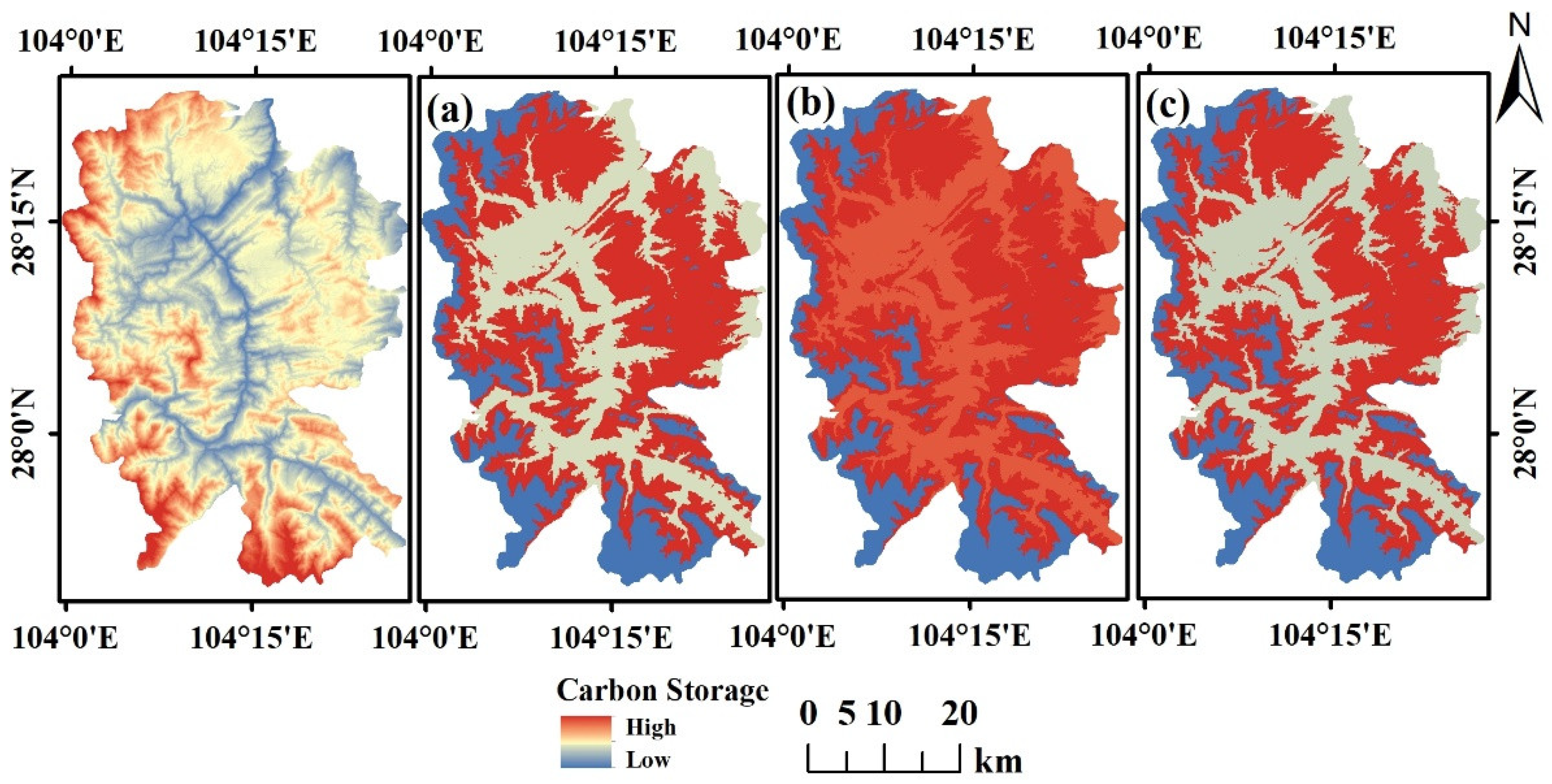
| Land Use Type | Carbon Density | |||
|---|---|---|---|---|
| Ci-above | Ci-below | Ci-soil | Ci-dead | |
| Cropland | 26.41 | 5.28 | 43.94 | 2.64 |
| Forest | 44.75 | 8.95 | 52.71 | 4.48 |
| Grassland | 38.67 | 7.73 | 53.7 | 3.87 |
| Waterbody | 22.32 | 4.46 | 44.29 | 2.23 |
| Impervious | 18.24 | 3.65 | 41.61 | 1.82 |
| Data Name | Data Type | Resolution | Data Sources |
|---|---|---|---|
| Soil type | Raster | 30 m | http://www.resdc.cn/, accessed on 4 April 2024 |
| Elevation | Raster | 30 m | |
| Slope | Raster | 30 m | |
| Annual mean precipitation | Raster | 1 km | https://data.tpdc.ac.cn, accessed on 4 April 2024 |
| Annual mean temperature | Raster | 1 km | https://data.tpdc.ac.cn, accessed on 4 April 2024 |
| NDVI | Raster | 1 km | https://search.earthdata.nasa.gov/search, accessed on 4 April 2024 |
| Interaction | |
|---|---|
| q(X1∩X2) < Min(q(X1), q(X2)) | Non-linear decrease |
| min(q(X1), q(X2)) < q(X1∩X2) < max(q(X1), q(X2)) | Single-factor non-linear decrease |
| q(X1∩X2) > max(q(X1), q(X2)) | Double-factor enhancement |
| q(X1∩X2) = q(X1) + q(X2) | Independent |
| q(X1∩X2) > q(X1) + q(X2) | Non-linear enhancement |
| Land Use Type | 2000 | 2014 | 2019 | |||
|---|---|---|---|---|---|---|
| Area | % | Area | % | Area | % | |
| Cropland | 361.73 | 17.86 | 376.01 | 18.57 | 327.07 | 16.15 |
| Forest | 1657.12 | 81.83 | 1640.55 | 81.01 | 1688.44 | 83.37 |
| Grassland | 0.80 | 0.04 | 0.26 | 0.01 | 0.49 | 0.02 |
| Waterbody | 4.00 | 0.20 | 5.65 | 0.28 | 5.72 | 0.28 |
| Impervious | 1.49 | 0.07 | 2.68 | 0.13 | 3.43 | 0.17 |
| Land Use Type | 2000–2014 | 2014–2019 | ||||
|---|---|---|---|---|---|---|
| Transfer to | Transfer out | Total | Transfer to | Transfer out | Total | |
| Cropland | 112.73 | 98.45 | 14.28 | 36.54 | 85.48 | −48.94 |
| Forest | 96.09 | 112.67 | −16.57 | 84.30 | 36.41 | 47.89 |
| Grassland | 0.14 | 0.67 | −0.54 | 0.33 | 0.10 | 0.23 |
| Waterbody | 1.88 | 0.24 | 1.64 | 0.34 | 0.26 | 0.07 |
| Impervious | 1.50 | 0.31 | 1.19 | 0.80 | 0.06 | 0.74 |
| Land Use Type | 2000 | 2014 | 2019 |
|---|---|---|---|
| Cropland | 28.31 | 29.43 | 25.60 |
| Forest | 183.76 | 181.92 | 187.23 |
| Grassland | 0.08 | 0.03 | 0.05 |
| Waterbody | 0.29 | 0.41 | 0.42 |
| Impervious | 0.10 | 0.18 | 0.22 |
| Total | 212.54 | 211.97 | 213.52 |
| Year | Terrain | Climate | Environment | |||
|---|---|---|---|---|---|---|
| Slope | Elevation | Temperature | Rainfall | NDVI | Soil Type | |
| 2000 | 0.001 | 0.038 | 0.003 | 0.005 | 0.003 | 0.002 |
| 2014 | 0.003 | 0.056 | 0.001 | 0.000 | 0.008 | 0.005 |
| 2019 | 0.002 | 0.059 | 0.001 | 0.002 | 0.000 | 0.004 |
| Type | 2000–2014 | 2014–2019 | Total |
|---|---|---|---|
| Cropland to forest area/km2 | 95.76 | 84.27 | 180.03 |
| Cropland to grassland/km2 | 0.06 | 0.30 | 0.36 |
| Grassland to forest/km2 | 0.32 | 0.03 | 0.35 |
| Cropland to forest carbon sink contribution/×105 t | 3.12 | 2.75 | 5.87 |
| Cropland to grassland carbon sink contribution/t | 148.03 | 781.79 | 929.83 |
| Grassland to forest carbon sink contribution/t | 218.60 | 21.18 | 239.78 |
| Contribution of carbon sinks from fallowed land/×105 t | 3.13 | 2.76 | 5.88 |
| The amount of carbon lost/t | 3.71 | 1.2 | 4.91 |
| Time | Cropland–Forest | Cropland–Grassland | Grassland–Forest | Total |
|---|---|---|---|---|
| 2000–2014 | 3261.85 | 2467.17 | 683.13 | 6412.14 |
| 2014–2019 | 3261.95 | 2605.97 | 706.00 | 6573.92 |
| Change | 0.11 | 138.80 | 22.88 | 161.78 |
Disclaimer/Publisher’s Note: The statements, opinions and data contained in all publications are solely those of the individual author(s) and contributor(s) and not of MDPI and/or the editor(s). MDPI and/or the editor(s) disclaim responsibility for any injury to people or property resulting from any ideas, methods, instructions or products referred to in the content. |
© 2024 by the authors. Licensee MDPI, Basel, Switzerland. This article is an open access article distributed under the terms and conditions of the Creative Commons Attribution (CC BY) license (https://creativecommons.org/licenses/by/4.0/).
Share and Cite
He, Y.; Kou, W.; Chen, Y.; Lai, H.; Zhao, K. Returning Cropland to Grassland as a Potential Method for Increasing Carbon Storage in Dry-Hot Valley Areas. Sustainability 2024, 16, 4150. https://doi.org/10.3390/su16104150
He Y, Kou W, Chen Y, Lai H, Zhao K. Returning Cropland to Grassland as a Potential Method for Increasing Carbon Storage in Dry-Hot Valley Areas. Sustainability. 2024; 16(10):4150. https://doi.org/10.3390/su16104150
Chicago/Turabian StyleHe, Yakai, Weili Kou, Yue Chen, Hongyan Lai, and Kaifu Zhao. 2024. "Returning Cropland to Grassland as a Potential Method for Increasing Carbon Storage in Dry-Hot Valley Areas" Sustainability 16, no. 10: 4150. https://doi.org/10.3390/su16104150
APA StyleHe, Y., Kou, W., Chen, Y., Lai, H., & Zhao, K. (2024). Returning Cropland to Grassland as a Potential Method for Increasing Carbon Storage in Dry-Hot Valley Areas. Sustainability, 16(10), 4150. https://doi.org/10.3390/su16104150








